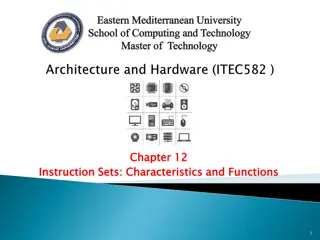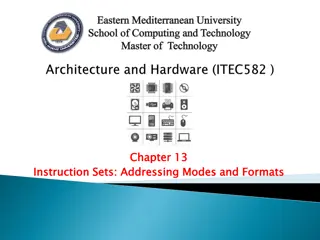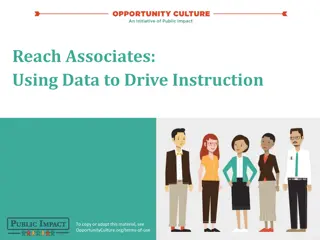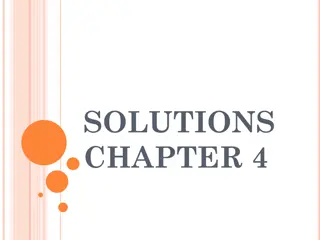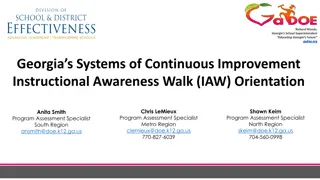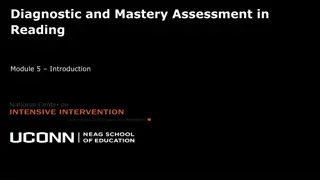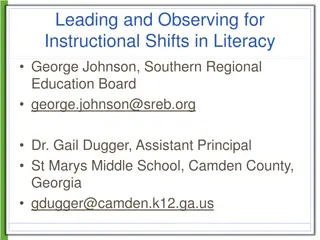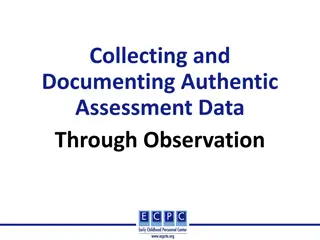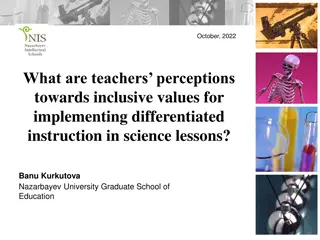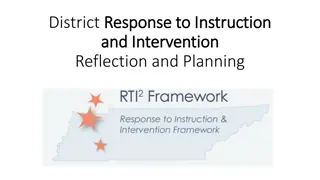Addressing Challenges in Utilizing Assessment Data in Science Instruction
In this scenario, an eighth-grade science teacher faces a dilemma where the assessment data being used does not align with the science standards being taught in the curriculum. This mismatch hinders the ability to use data effectively to drive instruction and make necessary curriculum changes. The issue raises questions about accountability to science standards and the disconnect between data-driven decision-making and teaching science subjects.
Download Presentation

Please find below an Image/Link to download the presentation.
The content on the website is provided AS IS for your information and personal use only. It may not be sold, licensed, or shared on other websites without obtaining consent from the author. Download presentation by click this link. If you encounter any issues during the download, it is possible that the publisher has removed the file from their server.
E N D
Presentation Transcript
Using Data: Identifying Problems Using Data: Identifying Problems- -Finding Solutions Finding Solutions DATAG: Learning and Leading Through Uncertainties July 15, 2021 Nancy W. Sindelar, Ph.D.
In a perfect standards In a perfect standards- -based environment, schools follow these steps based environment, schools follow these steps for building an efficient system to gather and use assessment data for building an efficient system to gather and use assessment data 1. Content Standards-What should students Know? 2. Standards-based Curriculum-Road map for teachers 3. Standards-based Assessments-Measurement of Student Progress toward standards 4. Analysis and use of assessment data disaggregated by standard by administrators and classroom teachers -How we know if they know it? What will we do if they don t know it? 5. Standards-based Report Card-Communication to students and parents regarding what students know and what they don t know.
Steps for Gathering and Using Classroom Test Data to Steps for Gathering and Using Classroom Test Data to Inform Teaching and Monitor Student Progress Inform Teaching and Monitor Student Progress 1. The curriculum and classroom assessments are aligned to standards. 2. A data-based system is used to monitor each student s progress toward standards and learning targets. 3. Assessments go through item analysis and teacher and student friendly reports are generated and used. 4. PLC/team time is used to discuss student achievement. The focus is on evidence of achievement or lack of it. They begin with data, focus on results, rather than opinions, and end with action plans. 5. Student achievement is documented on standards-based report cards.
Using testimonials from teachers, were going to: Using testimonials from teachers, we re going to: Look at a problem Look at a problem Identify the issue Identify the issue Find/discuss the solution Find/discuss the solution
Problem #1 Problem #1 Here s the problem (Eighth grade science teacher) In my building we use data as often as possible. In the fall we assess to check students abilities, in December we check progress, and finally in the spring we check how students have grown. We do this using i-Ready, which tests students on their reading and math capabilities. Although this assessment is used to track students academic ability, this assessment does not align with the science standards and targets we are teaching in class. Teachers do not feel their teaching is connected to i-Ready data, and because of this, they are not using data to make essential changes in curriculum or using data to drive instruction. We are being asked to base science instruction on data that does not focus on science itself and are relegated to focusing on teaching subjects and content not directly related to our science curriculum. How do we focus on learning science standards when we are not held accountable to those standards by the district?
Problem #1 Problem #1 What s the issue? Alignment of curriculum and assessments to standards What s the solution? The district should invest in proper diagnostic testing for every subject so that data can drive instruction.
Problem #2 Problem #2 Here s the problem (High school English teacher) This year our district unveiled a School Improvement Plan titled: Equity and Excellence. Its focus explores ways to boost student engagement and success, specifically focusing on minority student groups. In the plan, the district has pledged the overall failure rate will decrease by 5% for all students and the failure rate for low income, African American, and Hispanic, students will decrease by 8%. At the opening institute for faculty, this improvement plan was introduced without providing context as to how we arrived at this point or what we will specifically do, as a school, to ensure the goal is reached. The concern from many teachers, including myself, is the arbitrary nature of these data points. What is the current failure rate of students? How were these goal percentages determined?
Problem #2 Problem #2 What s the issue? Not a SMART goal (Strategic, Measurable, Achievable, Realistic, Timebound) What s the solution? In order for this plan to unfold, we must explore where, specifically, failure is occurring. Is there a department and/or course with a disproportionate amount of underachieving students? Within those specific courses, is there a specific grade category in which students are underperforming? Once these questions are answered, we should know how to move forward. We should use of pre-assessments to target prerequisites then identify groupings, we should use the data to form intervention classes, which will provide better data than data from i-Ready.
Problem #3 Problem #3 Here s the problem. (High School English teacher) In prior years, summative assessment were determined by individual teachers; and data could not be compared/discussed among teachers since there were a plethora of assessments being used to test a wide range of skills. This year, the freshman team is using a newly developed curriculum in an attempt to design a course directly linked to Common Core learning targets using common assessments with clearly outlined rubrics. While the rubrics are consistent among teachers, data collection is not. Some teachers grade using paper rubrics while others use online software on Turnitin or Google Classroom. Thus, while data is being collected by individual teachers, it is not necessarily done in a way the allows for sharing and/or comparative analysis. When it comes to data-driven instruction to improve the curriculum, and teaching and learning, we are starting from ground zero.
Problem #3 Problem #3 What s the issue? Collecting data, but not using it. DRIP Syndrome. What s the solution? All teachers must begin collecting data in a consistent manner. We are still stuck in the trap of using test results to assign and grade and moving onto the next thing without taking the time to remediate and/or reflect. Once we determine common means of data collection, we will have the information we need to define next steps for learning and the ability to develop a sequential system for student improvement.
Problem #4 Problem #4 Here s the problem (High school Chemistry teacher) Before the state mandated that we realign our curriculum to the Next Generation Science Standards, our Chemistry PLC constantly used data to improve both our assessments and our instruction. Before NGSS, all test and quizzes were tagged by our old standards in the Mastery Manager system. After each assessment, it was possible to go back and see how each student or each class did on a particular standard, sub- standard or question. This wealth of data strongly influenced how our PLC would do everything from writing test questions to tweaking our instructional approaches. Since NGSS changed the curriculum, we no longer use our PLC time to analyze data, but rather spend it on pedagogical methods and approaches that need to be shifted.
Problem #4 Problem #4 What s the issue? It s a process. They need to move on. What s the solution? It s time we apply our successful approach to our old curriculum to our new one. The best way to start to do this would be to prioritize the sub-standards, and then tag our assessments in Mastery Manager so we can truly see how effective our teaching is Once we begin using data again to analyze our assessments, then we can resume our practice of making meaningful, calculated adjustments to our instruction.
Problem #5 Problem #5 Here s the problem (High school Social Studies teacher) Despite our PLC s access to a wide variety of tools for analyzing student test data, our PLC comes up short in using data as an instructional tool. None of the systems are being fully utilized by teachers. Tableau is a very powerful data analysis program; however, we only use this software to check for student growth or proficiency on two sets of tests.
Problem #5 Problem #5 What s the issue? Staff development What s the solution? Given the sheer size of our district and the large number of technologically inclined teachers, I feel that allowing teachers full access to a potent data analysis program would allow them to more efficiently analyze their student s assessment data.
Problem #6 Problem #6 Here s the problem When our district issued every student an iPad for instructional purposes six years ago, there was plenty of professional development offered on how to incorporate these devices into the classroom. However, after a few short years, there are few to no opportunities for teachers to learn about new features on these systems that can make positive impact on day-to-day instruction. The best example of this would be using Schoology to implement a standards-referenced framework for a course. While there are a few teachers who have taught themselves how to do a standards- referenced grading system on Schoology, it is complex and time consuming to do so. Typically, teachers who trailblaze a new idea are offered an opportunity to do an in-district course on the topic. However, when these teachers asked if they could teach their new skills to other educators , their request was denied.
Problem #6 Problem #6 What s the issue? Staff development What s the solution? It would be an incredibly valuable experience for teachers to be able to see how Schoology can be used in a way other than to digitally distribute and collect assignments.
Problem #7 Problem #7 Here s the problem (Eighth grade math teacher) Sometimes we re guilty of giving an assessment and then moving on due to limited time. Though we have test analysis reports from standards-based assessments and data for students to see next-steps and growth, we don't provide the time and feedback to allow students to meet learning targets and standards because we feel pressured to move through the curriculum.
Problem #7 Problem #7 What s the issue? DRIP syndrome What s the solution? Assessment Powered teachers have seen success breed success by using assessment results to provide timely next-steps feedback to students ...
Problem #8 Problem #8 Here s the problem. (High school government and economics teacher) I am teaching Government and Economics for the first time and learning more about my PLC, the course, and the curriculum as each week passes. Currently, we have met three times as a PLC and have only focused gathering resources, lessons plans and sharing best practices. We have yet to discuss any formative or common assessments or data analyses. Additionally, we have yet to discuss data from last year to adjust our current curriculum or make changes to this year s instruction. To date, I have given two unit assessments that have been used in years past. Our PLC has not analyzed or cross referenced our assessments with our curriculum to assure alignment.
Problem #8 Problem #8 What s the issue? Data collection is a process; it s time to move on. What s the solution? Our focus should be aimed at creating a plan to gather and analyze assessment data. We should begin tagging our current assessments through our test assessment software, Mastery Manager. This will allow us to compare which standards our students are being assessed on and where our discrepancies exist. The district also has purchased an advanced data analysis tool, Tableau, which in help identify how each subgroup is doing per assessment.
Problem #9 Problem #9 Here s the problem (Sixth grade teacher) Although PLCs meet on a regular basis, there s not enough time to get through all the tasks and discussions that need to be accomplished. An agenda is created by our PLC leader to state our goals and topics of discussion for the meeting, but often the agenda is not updated until we start the meeting. Time is wasted with social discussion rather than data related conversations. Then we spend a lot of time discussing our classroom test data and reflect on possible modifications to curriculum and instructional strategies but are guilty of not making any plans to change them. Once a meeting comes to an end, we always leave saying, We will pick this up where we left off next time.
Problem #9 Problem #9 What s the issue? PLC is not making good use of their time. What s the solution? Every meeting should begin with an up-to-date agenda and end with an action plan to stimulate improvement in student achievement.
Problem #10 Problem #10 Here s the problem Data is shared with staff three times a year at data meetings. These meetings are extremely helpful for finding trends in data and identifying subgroups who are struggling. Teachers and PLCs make plans with how to move forward with instruction in ways that positively impact the students who need more. However, currently teachers do not have the resources to individually pull reports on how students in these subgroups are doing in their own classes and use this data to drive instruction While our school has programs that do this, such as Tableau, the teachers have not been trained and can t use it effectively to make more frequent interventions as problems arise.
Problem #10 Problem #10 What s the issue? Staff development What s the solution? Teachers need the power to look at their student s progress as subgroups so that they can better understand the trends in data and change instruction and interventions in their classes.
Principal Survey Findings Principal Survey Findings The majority of middle and high school principals have access to academic, attendance and discipline data on students with records usually broken down by student subgroups, according to a RAND Corp. nationally representative sample of principals. Disaggregated data on which courses students take can help administrators determine inequitable access to higher-level courses. This information is available for about half of middle school principals and two-thirds of high school principals. Opportunities for principals to meet with other administrators to review data and use it for school improvement suggests an opportunity to increase principals participation in data collaborations that allow them to learn from one another and share ideas about how to use data effectively. Test scores, attendance data and student discipline records often figure into principals decisions for choosing intervention programs. A smaller percentage, however, reported using test scores, grades and course enrollment data for decisions on instructional leadership. The authors note principals were least likely to use either academic or nonacademic data to make budget decisions. Source: Linda Jacobson, (2020) Education DIVE survey: principals of lack data students social emotional, postsecondary outcomes. Accessed July 5, 2021
Data Rich; Information Poor? Data Rich; Information Poor? Do you use disaggregated data to determine equitable/inequitable access to higher-level courses? Why/ Why not? Do you meet with other administrators to review data and use it for school improvement? Why/ Why not? Do you use data to make decisions about Instructional leadership? Intervention programs? Budget?
Data Rich; Information Poor Data Rich; Information Poor
References References Jacobson, Linda (2020) Education DIVE survey: principals of lack data students social emotional, postsecondary outcomes. Accessed July 5, 2021 Sindelar, N. (2010) Assessment-Powered Teaching. Thousand Oaks, CA






